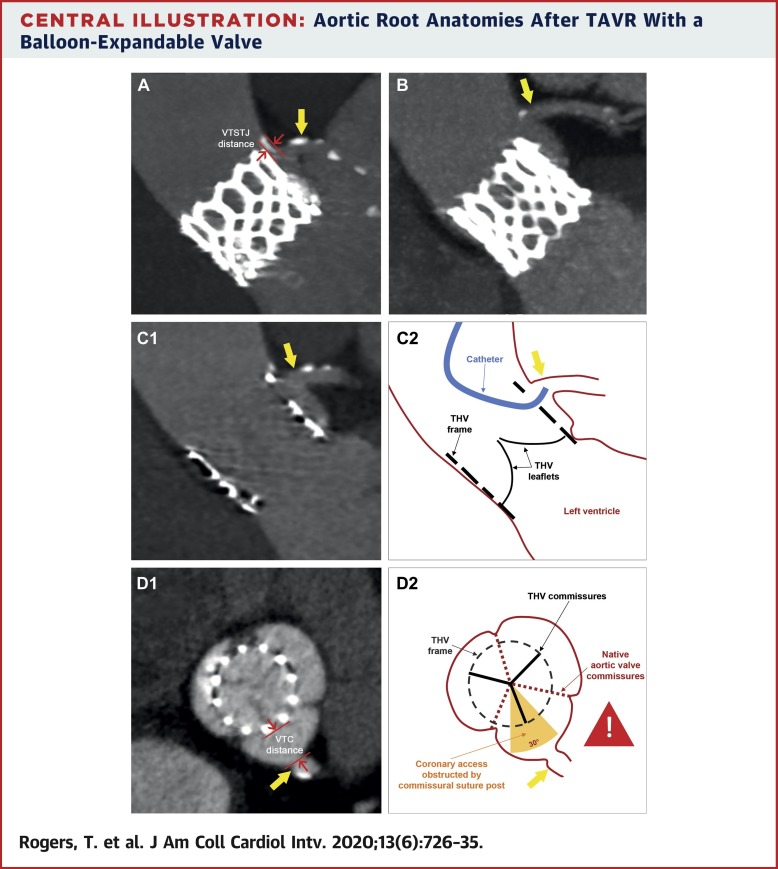JACC: Cardiovascular Interventions ( IF 11.7 ) Pub Date : 2020-03-16 , DOI: 10.1016/j.jcin.2020.01.202 Toby Rogers 1 , Benjamin C Greenspun 2 , Gaby Weissman 3 , Rebecca Torguson 2 , Paige Craig 2 , Christian Shults 4 , Paul Gordon 5 , Afshin Ehsan 6 , Sean R Wilson 7 , John Goncalves 8 , Robert Levitt 9 , Chiwon Hahn 10 , Puja Parikh 11 , Thomas Bilfinger 12 , David Butzel 13 , Scott Buchanan 13 , Nicholas Hanna 14 , Robert Garrett 15 , Maurice Buchbinder 16 , Federico Asch 17 , Hector M Garcia-Garcia 17 , Petros Okubagzi 2 , Itsik Ben-Dor 2 , Lowell F Satler 2 , Ron Waksman 2

|
Objectives
The aim of this study was to evaluate the feasibility of coronary access and aortic valve reintervention in low-risk patients undergoing transcatheter aortic valve replacement (TAVR) with a balloon-expandable transcatheter heart valve (THV).
Background
Younger, low-risk TAVR patients are more likely than older, higher risk patients to require coronary angiography, percutaneous coronary intervention, or aortic valve reintervention, but their THVs may impede coronary access and cause coronary obstruction during TAVR-in-TAVR.
Methods
The LRT (Low Risk TAVR) trial (NCT02628899) enrolled 200 subjects with symptomatic severe aortic stenosis to undergo TAVR using commercially available THVs. Subjects who received balloon-expandable THVs and who had 30-day cardiac computed tomographic scans were included in this study. In a subgroup, the feasibility of intentional THV crimping on the delivery catheter to pre-determine commissural alignment was tested.
Results
In the LRT trial, 168 subjects received balloon-expandable THVs and had 30-day cardiac computed tomographic scans, of which 137 were of adequate image quality for analysis. The most challenging anatomy for coronary access (THV frame above and commissural suture post in front of a coronary ostium) was observed in 9% to 13% of subjects. Intentional THV crimping did not appear to meaningfully affect commissural alignment. The THV frame extended above the sinotubular junction in 21% of subjects, and in 13%, the distance between the THV and the sinotubular junction was <2 mm, signifying that TAVR-in-TAVR may not be feasible without causing coronary obstruction.
Conclusions
TAVR may present challenges to future coronary access and aortic valve reintervention in a substantial number of low-risk patients.
中文翻译:

低风险TAVR患者进行冠状动脉介入和主动脉瓣再介入的可行性。
目标
这项研究的目的是评估在接受球囊扩张式经导管心脏瓣膜置换术(TAV)的经导管主动脉瓣置换术(TAVR)的低危患者中冠状动脉通路和主动脉瓣膜再介入的可行性。
背景
年轻,低风险的TAVR患者比年长,高风险的患者更有可能需要冠状动脉造影,经皮冠状动脉介入治疗或主动脉瓣再介入,但他们的THV可能会阻碍冠状动脉的通行并在TAVR-in-TAVR期间引起冠状动脉阻塞。
方法
LRT(低风险TAVR)试验(NCT02628899)招募了200名有症状的严重主动脉瓣狭窄的受试者,使用市售THV进行TAVR。该研究包括接受球囊扩张性THV并进行了30天心脏计算机断层扫描的受试者。在一个亚组中,测试了在输送导管上进行有意THV压接以预先确定连合对齐的可行性。
结果
在LRT试验中,有168名受试者接受了球囊扩张型THV,并进行了30天的心脏计算机断层扫描,其中137名具有足够的图像质量进行分析。在9%至13%的受试者中观察到了最具挑战性的冠状动脉解剖结构(上方的THV框架和冠状动脉口前的连合缝合线)。故意的THV压接似乎没有显着影响连合对齐。THV框架在21%的受试者中延伸至鼻管交界上方,在13%的受试者中,THV与鼻管交界之间的距离小于2 mm,这表明TAVR-in-TAVR在不引起冠状动脉阻塞的情况下可能不可行。
结论
TAVR可能对许多低风险患者的未来冠脉介入和主动脉瓣再介入提出挑战。











































 京公网安备 11010802027423号
京公网安备 11010802027423号